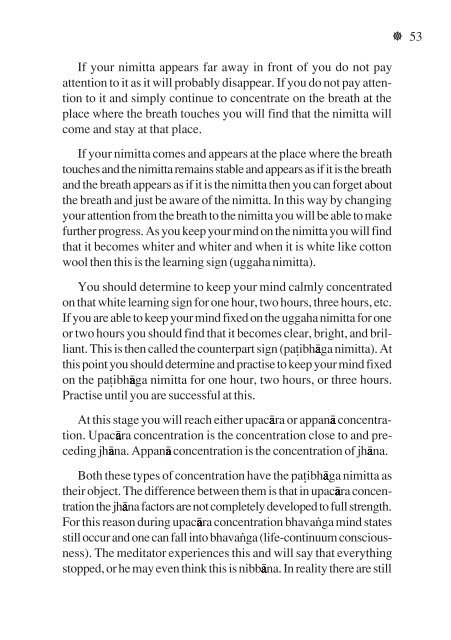The Practice Which leads to Nibbana - A Buddhist Library
The Practice Which leads to Nibbana - A Buddhist Library
The Practice Which leads to Nibbana - A Buddhist Library
Create successful ePaper yourself
Turn your PDF publications into a flip-book with our unique Google optimized e-Paper software.
If your nimitta appears far away in front of you do not payattention <strong>to</strong> it as it will probably disappear. If you do not pay attention<strong>to</strong> it and simply continue <strong>to</strong> concentrate on the breath at theplace where the breath <strong>to</strong>uches you will find that the nimitta willcome and stay at that place.If your nimitta comes and appears at the place where the breath<strong>to</strong>uches and the nimitta remains stable and appears as if it is the breathand the breath appears as if it is the nimitta then you can forget aboutthe breath and just be aware of the nimitta. In this way by changingyour attention from the breath <strong>to</strong> the nimitta you will be able <strong>to</strong> makefurther progress. As you keep your mind on the nimitta you will findthat it becomes whiter and whiter and when it is white like cot<strong>to</strong>nwool then this is the learning sign (uggaha nimitta).You should determine <strong>to</strong> keep your mind calmly concentratedon that white learning sign for one hour, two hours, three hours, etc.If you are able <strong>to</strong> keep your mind fixed on the uggaha nimitta for oneor two hours you should find that it becomes clear, bright, and brilliant.This is then called the counterpart sign (paÊibhŒga nimitta). Atthis point you should determine and practise <strong>to</strong> keep your mind fixedon the paÊibhŒga nimitta for one hour, two hours, or three hours.Practise until you are successful at this.At this stage you will reach either upacŒra or appanŒ concentration.UpacŒra concentration is the concentration close <strong>to</strong> and precedingjhŒna. AppanŒ concentration is the concentration of jhŒna.Both these types of concentration have the paÊibhŒga nimitta astheir object. <strong>The</strong> difference between them is that in upacŒra concentrationthe jhŒna fac<strong>to</strong>rs are not completely developed <strong>to</strong> full strength.For this reason during upacŒra concentration bhavaºga mind statesstill occur and one can fall in<strong>to</strong> bhavaºga (life-continuum consciousness).<strong>The</strong> medita<strong>to</strong>r experiences this and will say that everythings<strong>to</strong>pped, or he may even think this is nibbŒna. In reality there are stillw 53



![Path of Freedom [Vimuttimagga]](https://img.yumpu.com/49098667/1/177x260/path-of-freedom-vimuttimagga.jpg?quality=85)






